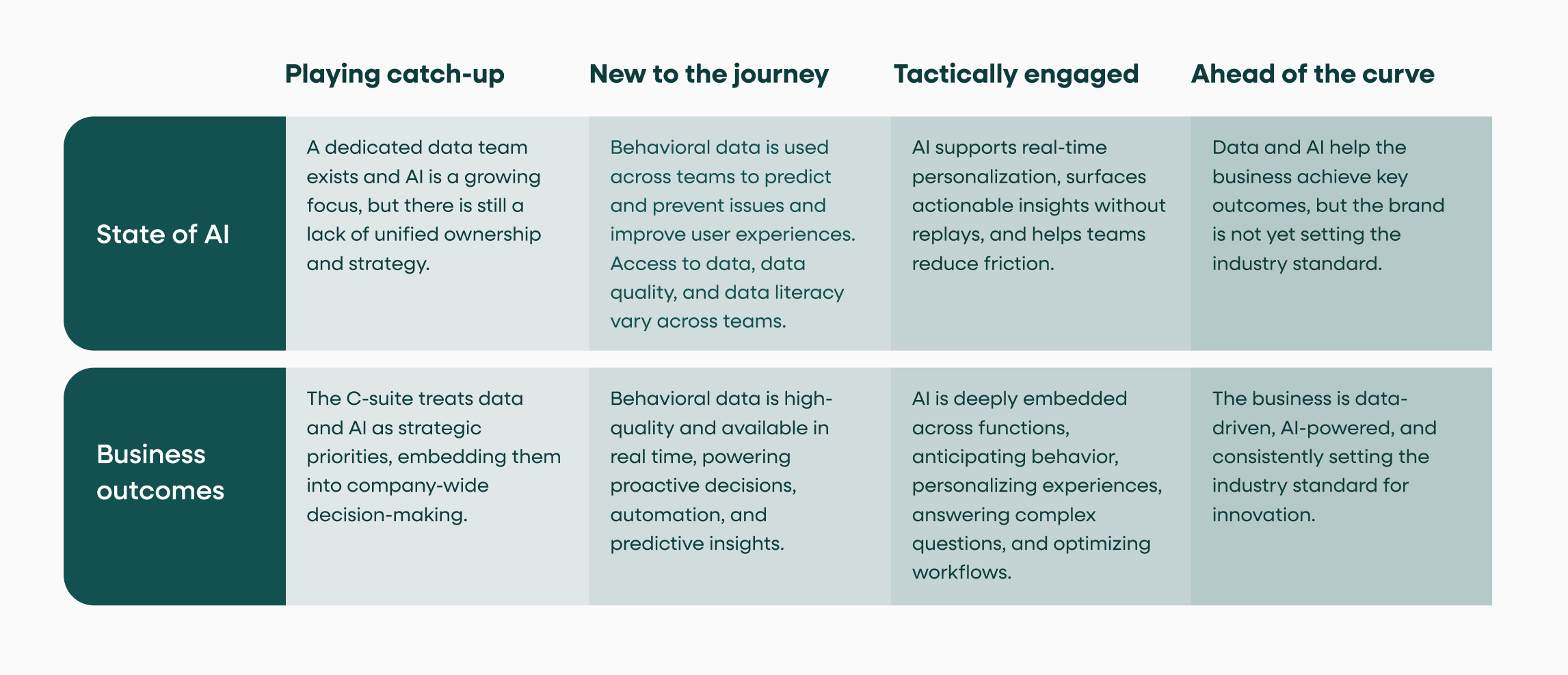AI is everywhere, but no two businesses are using it exactly the same way. That makes it hard to evaluate how mature your organization is in its AI journey; there’s no clear benchmark to compare yourself against.
Maybe you’ve launched some pilots. Maybe you’ve added AI into a few workflows. But without trustworthy data or a clear read on where you stand, it’s easy to overestimate progress or miss what’s holding you back.
Knowing your AI maturity level is how you identify what’s working, what’s not, and what to do next. If any of this sounds familiar, your organization’s maturity might be what’s holding you back:
AI is on leadership’s radar, but there’s no clear strategy, stakeholder alignment, or consistent funding to move it forward.
Your behavioral data is scattered, siloed, or too messy to use in a meaningful way.
Teams still rely heavily on manual digging to get answers
AI is being tested in low-risk areas, but no one’s confident enough to use it for real business decisions.
Product and brand experience feel inconsistent, and customers aren’t getting the personalization they expect.
If even one of those hits home, you’re not alone. Luckily, you don’t have to stay stuck.
Want to see how your org stacks up?
Find your AI maturity level using our interactive matrix. Then get personalized resources and tips to help you take the next steps.
What is AI maturity?
AI maturity measures how effectively your organization uses AI, not just in isolated tools, but across teams, systems, and decisions.
It’s not only about having the right tech in place; it’s also about whether your data is connected and trustworthy, whether leaders are invested, and whether AI is driving meaningful outcomes. In short, AI maturity is the difference between just dabbling in AI and creating scalable, long-term change.
Stages of AI maturity
Our maturity matrix outlines four levels of organizational AI maturity:
Playing catch-up: AI is tested but not trusted.
New to the journey: AI is used for productivity, not strategy.
Tactically engaged: AI supports real-time personalization and surfaces actionable insights.
Ahead of the curve: AI is deeply embedded across all business functions.
But here’s the thing: AI maturity isn’t one-size-fits-all. You may be ahead of the curve in one area and playing catch-up in another. That’s why we look even further across four key dimensions:
Sponsorship: Is leadership actively backing your AI strategy?
State of behavioral data: Is your data clean, connected, and usable?
State of AI: Are tools integrated, or still stuck in pilots?
Business outcomes: Is AI moving the needle in measurable ways?
Your team might have a strong AI infrastructure but struggle to see consistent impact. Or maybe you’ve got great executive support but are still wrangling siloed data. Knowing your maturity stage in each of these areas helps you focus on what to improve next, without waiting for a total transformation.

Assess your organization's AI maturity
Before you scale anything, you’ve got to know where you actually stand. That’s what maturity is really about: clarity. Not just “Do we use AI?” but “Are we using it well, with the right data, in the right places, for the right outcomes?”
To get a clear picture, we recommend looking across four key areas:
Cultural buy-in and leadership support
If your teams are skeptical of AI or still relying on gut over data, you’re not alone. But cultural hesitation can quietly stall even the best tech stack. Maturity starts with people. That means executive alignment, open mindsets, and a shared belief that AI (done right) isn’t risky—it’s responsible. Without this, nothing sticks.
Data and infrastructure readiness
You can’t build high-impact AI on shaky data foundations. If your org’s data is fragmented, slow, or just plain hard to trust, it’s a signal your data maturity and infrastructure need work. Mature teams invest early in clean, connected systems, where real-time data is accessible, trustworthy, and useful across teams.
Skills and talent development
AI isn’t plug-and-play. From product to marketing to ops, your teams need the know-how to ask smart questions and interpret what AI gives back. That doesn’t mean everyone has to be a data scientist. But it does mean creating space to skill up and embedding AI into how people work every day, not just in isolated pockets.
Responsible governance and ethics
Mature organizations don’t treat ethics as an afterthought. They build guardrails into every stage, ensuring data is handled responsibly, decisions are explainable, and models don’t quietly go off the rails. Strong governance doesn’t slow things down; it’s what makes maturity sustainable.
Build a strong foundation for AI Maturity
Think of organizational AI maturity like building a house; you need a solid foundation before adding smart features. Too often, companies jump into AI with excitement but no clear structure, and those projects quickly lose direction. Making real progress starts with aligning your AI efforts to actual business goals and building the right infrastructure to support them.
The challenge isn’t usually a lack of ambition; it’s the disconnect between AI initiatives and the day-to-day realities of the business. Without a strategy grounded in both technology and operations, even the best AI tools won’t gain traction. That’s why smart organizations focus early on cross-functional alignment, executive buy-in, and a roadmap built around their current capabilities and future vision.
Let’s break down the three areas that matter most when laying this foundation.
1. Executive sponsorship
AI won’t stick without leadership backing it up. When executives actively support AI initiatives, and not just in words, teams get the resources, visibility, and momentum needed to move forward. Whether it’s standing up an AI center of excellence or regularly reviewing AI outcomes against business goals, executive involvement sends a clear message that AI is part of the company’s future.
2. Technology investments
Getting serious about AI means investing in the right tools. Scalable, cloud-based platforms break down data silos and connect teams to the data and resources they need. And the rise of low-code AI and predictive modeling tools means you don’t need a team of data scientists to get meaningful results. It’s about enabling more people to build, test, and deploy smarter solutions faster.
But there’s a tech maturity curve here, too. It’s not just what you buy, it’s how you secure it, govern it, and connect it to your larger ecosystem. From privacy standards to vendor transparency, organizations that take a “secure and scalable” approach to AI are better positioned to grow confidently and responsibly.
3. Operational integration
AI isn’t a magic add-on to your existing processes; it only works if it’s woven into them. Instead of launching huge, sweeping AI programs out of the gate, start with small pilot projects in targeted areas. This gives you space to test, learn, and refine before rolling out across the business.
Real AI maturity takes shape when teams across departments begin to trust and use AI in their daily decision-making. That kind of integration doesn’t happen overnight, but it does happen faster when you focus on practical, high-impact use cases and build cross-functional teams that understand both the tech and the business challenge.
Accelerate AI adoption and integration
A structured approach to AI maturity gives companies a clear roadmap to scale AI adoption, enhancing business impact. AI transformation is projected to outpace digital transformation by 16 months, highlighting the need for rapid integration strategies. Successfully scaling AI can significantly reduce costs and improve profitability by automating processes and enhancing decision-making.
Companies with advanced AI capabilities can respond faster to market changes, gaining a notable edge over competitors. Leveraging data analytics, these organizations outperform competitors by predicting market trends and capitalizing on insights more effectively, positioning them as data leaders.
Pilot programs
Starting with pilot programs allows organizations to test AI applications on a smaller scale before full deployment, minimizing risks and providing valuable insights into AI integration. Focusing on specific pilot projects helps identify challenges and refine strategies for broader implementation.
Pilot programs gather data, measure performance, and adjust AI solutions to fit organizational needs, building a stronger case for AI investment by demonstrating tangible benefits and ROI, encouraging broader AI adoption.
Scaling AI solutions
The urgency for transformation, driven by events like the pandemic, highlights the need for rapid adaptation. Scaling AI solutions requires integrating AI into core business processes and aligning all departments with AI objectives, enhancing AI capabilities, and maturity.
Organizations that scale AI effectively can automate processes, improve processes, improve decision-making, and achieve substantial cost savings. They can also more effectively capitalize on market insights, establishing a stronger competitive position.
Strategic scaling of AI solutions positions organizations as industry best practices leaders, continuously pushing the boundaries of innovation.
Continuous improvement
Encouraging a culture of continuous learning and iteration helps organizations effectively refine their AI implementations. Ongoing learning and adaptation are crucial for keeping AI processes aligned with evolving business needs and maintaining effectiveness. Continuous improvement involves regularly updating algorithms and processes based on new data and feedback to enhance performance.
Organizations that prioritize continuous improvement can optimize their AI processes and remain competitive in a rapidly changing landscape. This commitment to ongoing enhancement ensures that AI technologies continue to deliver value and drive innovation within the organization.
Lean into AI for innovation and growth
Organizations that successfully advance in AI maturity can achieve a significant competitive edge and enhanced operational efficiency. AI technologies enable companies to transform their operations and create new opportunities for innovation. Leading tech firms, for example, have integrated AI deeply into their operations, resulting in enhanced performance and competitive advantage.
Leveraging AI effectively allows organizations to unlock new levels of innovation, streamline operations, and improve customer experiences. Cloud-based platforms enhance the management of data, enabling organizations to create innovative customer experiences and uncover new business opportunities.
Successful pilot programs can also help identify high-impact AI use cases that support organizational goals.
Enhance customer experiences
AI enables companies to analyze customer data and behavior, allowing for tailored experiences that meet individual preferences. By utilizing machine learning algorithms, AI can recommend products or services based on previous purchases and browsing history, leading to more personalized interactions. These personalized interactions not only enhance customer loyalty and engagement but also directly contribute to higher satisfaction rates.
AI in customer experience elevates the entire digital experience and contributes to stronger business outcomes. Organizations that harness AI effectively can transform their customer engagement strategies, leading to significant advancements in efficiency and customer satisfaction.
Create new revenue streams
AI-ready organizations are developing and offering AI capability as a service, creating new business opportunities. Innovative AI solutions can open up new markets and revenue opportunities by automating processes and enhancing product offerings. AI applications can uncover previously untapped market opportunities, leading to new revenue generation.
Scaling AI beyond proofs of concept has significantly impacted ROI for AI initiatives. By leveraging AI technologies, organizations can create new revenue streams and drive business growth through innovative AI applications and services.
Find your competitive advantage
The majority of companies are still stuck in AI limbo, testing cautiously, avoiding risk, and waiting for the “perfect” solution. In fact, despite 60% reporting growth in AI usage, only 13% say their adoption is truly extensive. Most are holding back, and that hesitation has created an opening. That’s your competitive advantage.
When AI maturity goes beyond experimentation, when it’s woven into how you make decisions, deliver experiences, and respond to customers in real time, that’s when it stops being a tool and starts becoming a differentiator. Organizations that fully commit to AI with the right foundations in place see twice the impact in critical areas like user engagement and operational efficiency.
→ Want more insights like these? Check out our 2025 Reality Check report.
Turn AI ambition into a measurable impact
Wherever your organization sits on the AI maturity curve, one thing is clear: progress isn’t about chasing shiny tools or one-off pilots, it’s about building the right foundation and scaling with intent. AI maturity means using data you trust, applying AI where it actually drives impact, and continuously adapting as your business evolves.
It also means getting alignment from leadership to day-to-day teams, so AI becomes part of how your company operates, not just a side project. The organizations seeing the biggest return on AI aren’t always the ones with the most tools; they’re the ones connecting strategy, data, and action across the board.
Fullstory empowers teams to understand what customers are doing and why. That clarity helps businesses move faster, personalize smarter, and build better experiences with confidence. Whether you're just starting out or looking to level up, Fullstory gives you the visibility and context you need to bring AI to life in a meaningful way.
Check out our AI maturity assessment and get tailored insights to help your organization level up.







